Measurement units are essential for accurate communication in science, engineering, and daily life. Accessing a comprehensive measurement units chart in PDF provides a quick reference for conversions, ensuring precision and efficiency across various fields.
1.1 Importance of Measurement Units in Science and Daily Life
Measurement units are fundamental in science and daily life, ensuring clarity and consistency. They enable precise communication, facilitating scientific research, engineering, and global trade. Standardized units like meters, kilograms, and liters simplify comparisons and calculations. In everyday activities, such as cooking or construction, accurate measurements prevent errors. A measurement units chart PDF serves as a handy reference, aiding professionals and students alike in understanding and converting units efficiently. This consistency is vital for education, innovation, and practical applications across all fields.
1.2 Brief Overview of Metric and Customary Systems
The metric system, based on SI units, is widely used globally for its consistency and logic. It includes units like meters, liters, and kilograms. The customary system, used primarily in the US, relies on inches, feet, and pounds. Both systems are essential for understanding measurements. A measurement units chart PDF provides a clear comparison, helping users grasp conversions between these systems. This dual understanding is crucial for international collaboration and everyday applications.
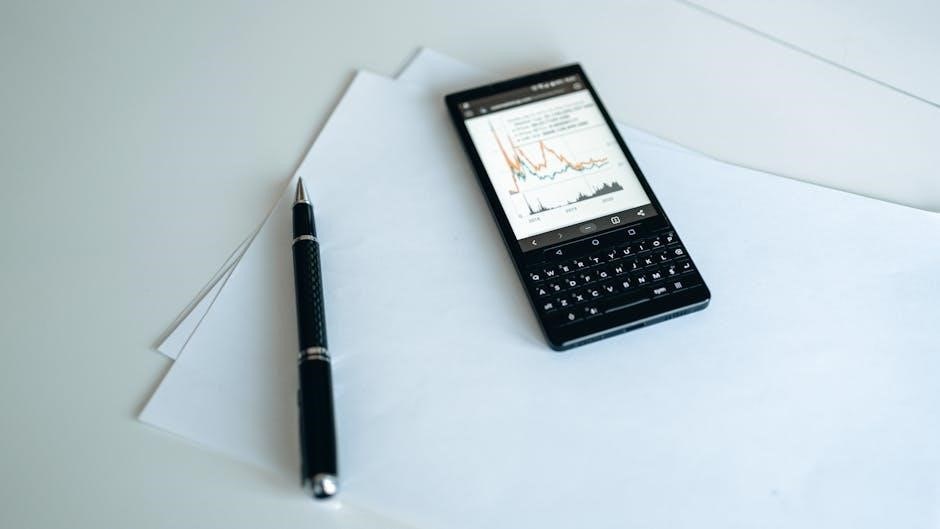
Metric System Basics
The metric system is based on SI units, with primary units like meters for length, liters for volume, and kilograms for mass. Common prefixes include kilo-, milli-, and centi-. A measurement units chart PDF simplifies understanding these fundamentals.
2.1 Primary Metric Units (Length, Mass, Volume)
The metric system’s core units include meters for length, kilograms for mass, and liters for volume. These base units are essential for all metric conversions. A measurement units chart PDF provides a clear, organized reference for understanding and converting these fundamental units efficiently. This chart is widely used in education, science, and daily applications to ensure accuracy and consistency in measurements.
2.2 Common Metric Prefixes (Kilo-, Milli-, Centi-)
Metric prefixes simplify conversions by representing multiples or fractions of base units. Kilo- denotes 1,000, milli- represents one-thousandth, and centi- signifies one-hundredth. These prefixes are applied to length, mass, and volume units, such as kilometers (km), milliliters (mL), and centimeters (cm). A measurement units chart PDF organizes these prefixes, enabling quick reference for conversions. This systematic approach ensures clarity and consistency in scientific and everyday applications.
2.3 Temperature Conversion (Celsius, Kelvin)
The relationship between Celsius and Kelvin is fundamental for temperature conversions. To convert Celsius to Kelvin, add 273.15 (e.g., 0°C = 273.15 K). A measurement units chart PDF often includes these formulas, enabling quick reference. For example, water freezes at 0°C (273.15 K) and boils at 100°C (373.15 K). This consistency is crucial in scientific and engineering applications, ensuring accurate temperature measurements across various fields.
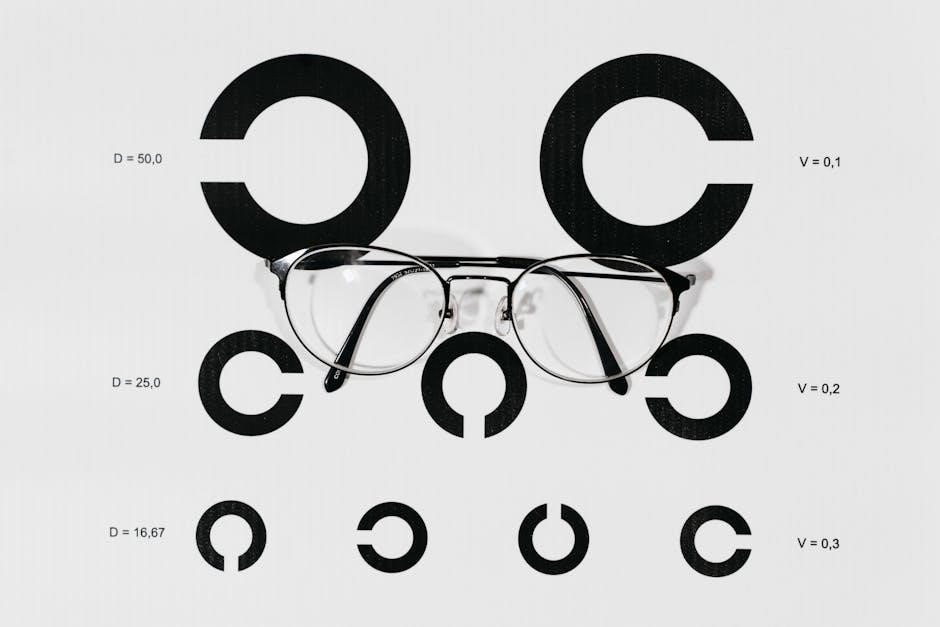
US Customary System Basics
The US Customary System uses units like inches, pounds, and fluid ounces. It is part of the Imperial system but with some differences. A measurement units chart PDF provides a handy reference for these units, simplifying conversions and everyday applications.
3;1 Primary US Units (Length, Weight, Volume)
In the US Customary System, primary units include inches, feet, and miles for length; pounds and ounces for weight; and fluid ounces, cups, and gallons for volume. A measurement units chart PDF simplifies conversion between these units, enhancing accuracy in various applications like cooking, construction, and science. These charts are especially useful for understanding relationships between different unit types, ensuring consistency and precision in measurements.
3.2 Common Conversions Within the US System
Within the US system, common conversions include 12 inches to 1 foot, 3 feet to 1 yard, and 5280 feet to 1 mile for length. For weight, 16 ounces equal 1 pound, and 2000 pounds make 1 ton. Volume conversions include 8 fluid ounces to 1 cup, 2 cups to 1 pint, 4 quarts to 1 gallon, and 31.5 gallons to 1 barrel. A measurement units chart PDF offers a clear, organized way to reference these conversions, ensuring accuracy and efficiency in various applications.
3.3 Fluid Ounces and Their Equivalents
Fluid ounces are a key unit of volume in the US system, commonly used in cooking and everyday measurements. 1 cup equals 8 fluid ounces, while 2 cups make 1 pint, 4 quarts equal 1 gallon, and 128 fluid ounces make 1 gallon. A measurement units chart PDF provides a handy reference for these conversions, simplifying recipe adjustments and ensuring accurate measurements. This chart is particularly useful for baking and cooking, where precise volumes are essential.
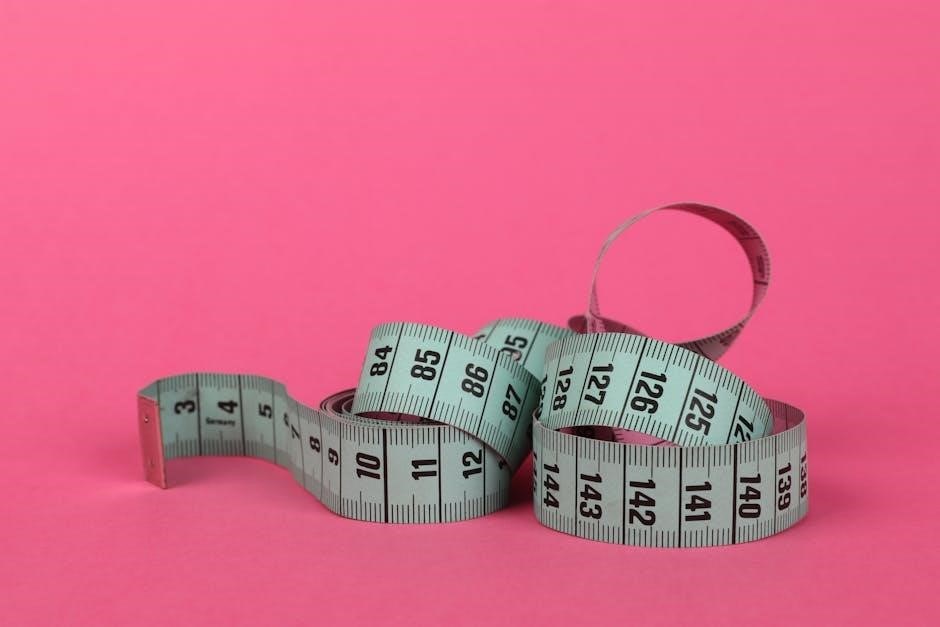
Conversion Between Metric and US Systems
A measurement units chart PDF simplifies conversions between metric and US systems, such as meters to feet, liters to gallons, and kilograms to pounds, ensuring clarity and accuracy.
4.1 Length Conversions (Meters to Feet, Kilometers to Miles)
A measurement units chart PDF provides precise length conversions, such as 1 meter equalling 3.28084 feet and 1 kilometer equaling 0.621371 miles. This resource is invaluable for engineers, travelers, and scientists needing quick reference. The chart simplifies complex conversions, ensuring accuracy in cross-system measurements. By downloading the PDF, users gain a handy tool for converting meters to feet and kilometers to miles effortlessly, saving time and reducing errors in calculations.
4.2 Mass Conversions (Kilograms to Pounds, Grams to Ounces)
A measurement units chart PDF simplifies mass conversions, such as 1 kilogram equalling approximately 2.20462 pounds and 1 gram equalling roughly 0.035274 ounces. This resource is crucial for precise calculations in science, cooking, and international trade. The chart provides a clear, organized format for converting kilograms to pounds and grams to ounces, ensuring accuracy and efficiency. Downloading the PDF offers a handy, portable tool for quick mass unit conversions, catering to professionals and everyday users alike.
4.3 Volume Conversions (Liters to Gallons, Milliliters to Fluid Ounces)
A volume conversion chart PDF provides essential equivalences, such as 1 liter equaling 0.2642 gallons and 1 milliliter equating to 0.0338 fluid ounces. This PDF is a vital resource for industries like engineering, cooking, and manufacturing. By offering a concise and organized format, it ensures accurate volume conversions between metric and US systems. Downloading the chart allows for easy access, making it an indispensable tool for professionals and home users requiring precise volume measurements.
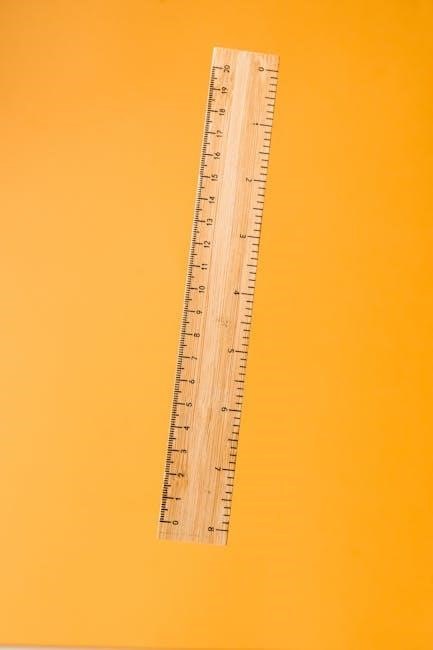
Temperature Conversion Formulas
This section provides essential formulas for converting temperatures, such as Celsius to Fahrenheit and Kelvin. A downloadable temperature conversion chart PDF is also available for quick reference.
5.1 Celsius to Fahrenheit and Vice Versa
The formula to convert Celsius to Fahrenheit is ( F = (C imes 1.8) + 32 ), while converting Fahrenheit to Celsius uses ( C = (F ― 32) / 1.8 ). These formulas are fundamental for temperature conversions. A downloadable temperature conversion chart PDF simplifies these calculations, offering a quick reference guide. Common conversions include freezing (0°C = 32°F) and boiling points (100°C = 212°F). This chart ensures accuracy and convenience for everyday use, education, and scientific applications.
5.2 Kelvin to Celsius and Fahrenheit Conversions
Kelvin to Celsius is calculated by subtracting 273.15 (K = C + 273.15). To convert Kelvin to Fahrenheit, use (F = (K — 273.15) × 1;8) + 32. These formulas are crucial for scientific applications. A temperature conversion chart PDF provides quick access to these conversions, ensuring accuracy. Common conversions include 0°C = 273.15 K and 100°C = 373.15 K. This chart is indispensable for understanding absolute temperature scales in physics and engineering.

Area and Volume Conversions
Convert square meters to square feet or acres, and cubic meters to gallons or cubic feet. These conversions are essential for construction and engineering. A measurement units chart PDF provides quick access to these equivalences, simplifying calculations for practical applications.
6.1 Square Meters to Square Feet and Acres
Converting square meters to square feet and acres is crucial in real estate and construction. One square meter equals approximately 10.764 square feet and 0.000247 acres. A measurement units chart PDF offers a detailed conversion table, enabling quick calculations. This reference is invaluable for professionals needing precise area measurements, ensuring accuracy in projects and transactions. Download a free PDF chart to streamline your area conversions effortlessly.
6.2 Cubic Meters to Cubic Feet and Gallons
Converting cubic meters to cubic feet and gallons is essential for engineering and construction projects. One cubic meter equals approximately 35.3147 cubic feet and 264.172 gallons. A measurement units chart PDF provides precise conversion factors, simplifying calculations. This reference is vital for professionals working with volume measurements, ensuring accuracy in fluid dynamics, storage, and construction. Download a free PDF chart to easily convert cubic meters to cubic feet and gallons for your projects.

Speed and Velocity Conversions
Convert speeds easily with a measurement units chart PDF. Key conversions include kilometers per hour to miles per hour and meters per second to feet per second.
7.1 Kilometers per Hour to Miles per Hour
Converting kilometers per hour (km/h) to miles per hour (mph) is crucial for understanding speed across different regions. A measurement units chart PDF simplifies this process, providing exact conversion factors. To convert km/h to mph, multiply the speed by 0.621371. For example, 100 km/h equals approximately 62.137 mph. This conversion is commonly used in automotive, aviation, and sports applications, ensuring accurate comparisons worldwide. The chart offers a quick reference, eliminating the need for manual calculations and reducing errors.
7.2 Meters per Second to Feet per Second
Converting meters per second (m/s) to feet per second (ft/s) is essential in various scientific and engineering applications. A measurement units chart PDF offers a precise conversion factor of 1 m/s = 3.28084 ft/s. For instance, 5 m/s equals 16.4042 ft/s. This conversion is vital for maintaining accuracy in fields like physics and engineering, where exact measurements are critical. The chart serves as a reliable reference, streamlining the conversion process and minimizing errors in calculations.

Unit Conversion Tools and Resources
Access online unit converters for real-time calculations, download printable PDF charts for offline use, and utilize mobile apps for convenient conversions on the go.
8.1 Online Unit Converters
Online unit converters are essential tools for quick and accurate conversions. They support various measurement types, including length, mass, volume, and temperature. These tools are user-friendly, offering real-time calculations and comprehensive unit databases. Many converters are free and accessible on multiple devices, making them ideal for students, professionals, and everyday use. They often include features like history tracking and conversion formulas, enhancing productivity. Popular platforms provide dedicated converters for specific needs, such as cooking or engineering, ensuring precise results. They are indispensable for seamless unit conversions in any context, anytime, anywhere.
8.2 Printable Metric Conversion Charts
Printable metric conversion charts are invaluable for quick reference. Available in PDF format, they cover essential units like length, mass, and volume. These charts are easily downloadable and can be printed for offline use, making them perfect for classrooms, offices, or personal use. They often include common conversions, such as millimeters to meters, grams to kilograms, and milliliters to liters. Many charts are designed with clarity and readability in mind, featuring color-coded sections for different unit categories. They serve as a handy resource for anyone needing to convert units without relying on digital tools, ensuring accessibility and convenience. These charts are widely used by students, professionals, and hobbyists alike, providing a reliable and portable solution for metric conversions. Their simplicity and comprehensiveness make them an essential tool for everyday tasks and educational purposes.
8.4 Mobile Apps for Unit Conversions
Mobile apps for unit conversions offer convenience and portability. Apps like Universal Unit Convertor support various categories, including length, mass, and volume. They provide real-time conversions, offline access, and customizable favorites. Many apps feature intuitive interfaces, making them ideal for students, professionals, and travelers. They often include additional tools like history tracking and conversion formulas. These apps ensure quick and accurate conversions, catering to diverse needs and enhancing productivity on the go.
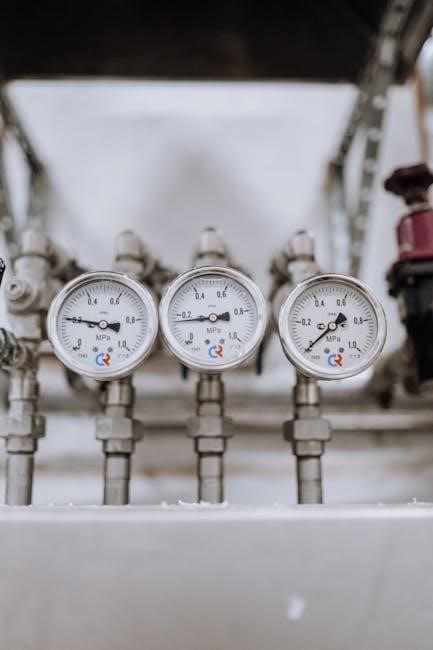
PDF Downloads for Measurement Units
Download free PDF charts for metric and customary units, featuring comprehensive conversion tables, formulas, and guides for creating custom measurement charts tailored to specific needs.
9.1 Free Metric Conversion Charts in PDF Format
Download free PDF metric conversion charts for length, mass, and volume. These charts provide essential conversions like millimeters to meters, grams to kilograms, and milliliters to liters. They are ideal for students, professionals, and anyone needing quick references. The charts are printable and cover SI units, making them versatile for both academic and practical applications. Access these resources to streamline your workflow and ensure accuracy in measurements.
9.2 Comprehensive Unit Conversion Tables in PDF
Comprehensive unit conversion tables in PDF offer detailed conversion factors for various measurement types, including length, mass, volume, and temperature. These tables cover SI units, US customary units, and their equivalents, providing a one-stop reference for precise conversions. They are ideal for professionals, students, and researchers, ensuring accuracy across diverse applications. Many PDFs include formulas and examples, making complex conversions straightforward and efficient.
9.3 How to Create Custom Measurement Charts in PDF
Creating custom measurement charts in PDF allows users to tailor unit conversions to specific needs. Tools like Excel or online converters can generate personalized tables. After inputting desired units and ranges, export the data as a PDF. This method ensures relevance and convenience, making it ideal for education, cooking, or professional tasks. Custom charts can be edited to include only necessary conversions, enhancing usability and reducing clutter for focused applications.
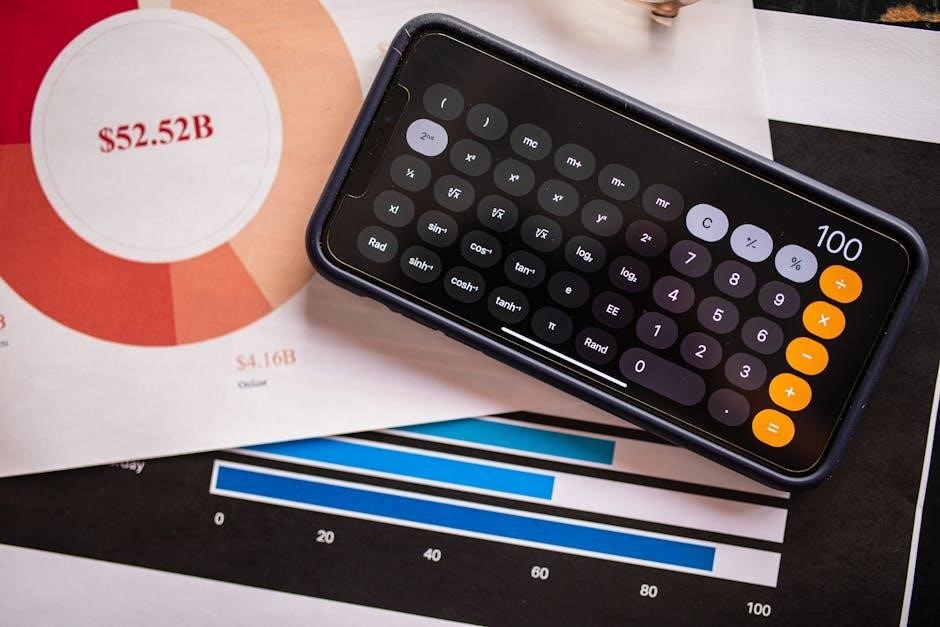
Applications of Measurement Unit Charts
Measurement unit charts are vital in science, engineering, cooking, and education; They simplify conversions, enhance accuracy, and streamline tasks, making them indispensable in daily and professional settings globally.
10.1 Science and Engineering
In science and engineering, measurement unit charts are indispensable for precise calculations. They facilitate conversions between metric and customary systems, ensuring accuracy in experiments, designs, and data analysis. Engineers rely on these charts for consistency across projects, while scientists use them to standardize measurements, enabling reliable comparisons and reproducibility of results. Accessing a PDF download of these charts allows professionals to work efficiently, whether in research or industrial applications, ensuring seamless communication and collaboration worldwide.
10.2 Cooking and Baking
Cooking and baking require precise measurements for successful recipes. A measurement units chart PDF download is a valuable tool, offering conversions between metric and customary units. This aids in scaling recipes, substituting ingredients, and ensuring accurate proportions. Whether converting grams to ounces or liters to cups, these charts simplify kitchen tasks. They are especially useful for international recipes, making it easier to adapt measurements for diverse culinary traditions and skill levels, ensuring delicious and consistent results every time.
10.3 Everyday Use and Education
A measurement units chart PDF download is invaluable for everyday tasks and educational purposes. It simplifies understanding and converting units, aiding in home improvement projects, cooking, and science education. Teachers and students benefit from clear, organized charts, making complex conversions accessible. The PDF format allows easy printing and sharing, ensuring everyone has a reliable reference for metric and customary systems, fostering better comprehension and practical application in daily life and learning environments.
A comprehensive measurement units chart PDF download serves as a vital reference for mastering conversions. It simplifies understanding and practical applications, ensuring accuracy and efficiency in various tasks and industries.
11.1 Summary of Key Conversion Factors
A comprehensive measurement units chart PDF download simplifies conversions, offering clear factors for length, mass, volume, and temperature. Key factors include meters to feet (1 m ≈ 3.281 ft), kilograms to pounds (1 kg ≈ 2.205 lb), liters to gallons (1 L ≈ 0.264 gal), and Celsius to Fahrenheit (°F = (°C × 1.8) + 32). These charts ensure accuracy and efficiency in science, cooking, and everyday tasks, making them indispensable tools for quick reference.
11.2 Final Tips for Mastering Unit Conversions
Mastery of unit conversions requires consistent practice and understanding of base units. Start with common conversions, like meters to feet or kilograms to pounds, and gradually move to more complex ones; Use a reliable measurement units chart PDF as a reference. Always double-check formulas, especially for temperature conversions. Familiarize yourself with metric prefixes and U.S. customary equivalents. Regularly applying these skills in real-world scenarios will enhance your proficiency and reduce errors in calculations.
